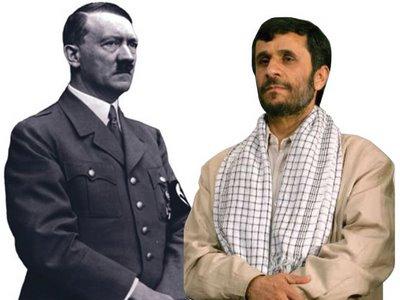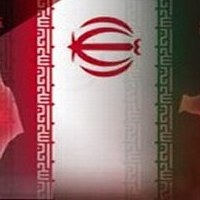![]()
January, 2010 | MatthiasKuentzel.de | By Matthias Küntzel
Iranian Antisemitism: Stepchild of German National Socialism
Originally published in “The Israel Journal of Foreign Affairs”, Volume Three Number One, January 2010/5769, p. 43-51. It’s reprinted here with permission of the author. See the Journal’s version here.
Many Iranians — including those in exile — claim that currently there is not any antisemitism in Iran. They point to the fact that the Jews of Iran today constitute the largest Jewish community in any Muslim country, which is true, and that even Mahmoud Ahmadinejad does not attack “the Jews,” but rather “the Zionists.”
At the same time, no other regime in the world is as antisemitic as that of the Mullahs in Tehran. It is true that Ahmadinejad does not attack “the Jews”, but instead claims that “two thousand Zionists want to rule the world.”[1] He says, “For sixty sears now, the Zionists” have blackmailed all western governments.”[2] “The Zionists have imposed themselves on a substantial portion of the banking, financial, cultural and media sectors.”[3] “The Zionists” are responsible for the Danish Muhammad cartoons. “The Zionists” are responsible for the destruction of the dome of the Golden Mosque in Iraq.[4] Of course, he invests the word “Zionist” with exactly the same sense with which Hitler once invested the word “Jew”: namely, that of being the incarnation of all evil. Whoever makes Jews responsible for all the ills of the world – whether as “Judas” or “Zionists” — is clearly driven by antisemitism.
Thus, in the special case of Iran we have both individual Jews, who are afforded some degree of protection as long as they agree to live in accordance with the religious concept of Dhimmitude and maintain a low profile, and the Jews in the abstract, i.e. “the Zionists,” who are considered to be the embodiment of global evil.
It is not hard to explain why individual Jews are more or less accepted in Iran: At least since the beginning of the rule of Reza Shah in 1925, the Iranian concept of “Aryanhood” included non-Muslim religious groups such as Christians, Zoroastrians and Jews. This concept of national integration (which also embraces Jews) remains somewhat applicable to this day.
The hatred of the abstract “Jew” and of Israel is more difficult to explain. Israel and Iran have no territorial disputes and there is no Iranian refugee issue; indeed, the pre-1979 period saw decades of good relations with Israel quite unlike the strained relation between Iranians and Arabs. In addition, the delusion of a “global Jewish power” was unknown in the Shia Muslim tradition. It is a hallmark of modern European antisemitism.
Thus the main question is when and how this kind of modern antisemitism, this hatred of the “abstract Jew”, was transplanted to Iran?
In the course of researching my study on the German-Iranian relationship over the past hundred years, I discovered archival documents that at least partly answer this question — documents relating to a period when the intensity of German-Iranian relations reached its peak: during World War II.[5]
It would behoove us to look at a few basic facts about the origins of the special relationship between Tehran and Berlin before examining new evidence about Nazi Germany’s antisemitic propaganda in Iran and drawing conclusions about its political ramifications.
Since the beginning of the twentieth century, Germany and Persia have made a great team. Persia needed Germany because it distrusted all the other great powers but was dependent on foreign technical assistance. Germany needed Iran because it was the only raw material-rich country as yet unconquered in the nineteenth-century struggle for colonies. These mutual interests produced an unparalleled level of cooperation between a Christian and a Muslim country.
Politically, the two countries shared common enemies from World War I onwards. Although Iran was officially neutral in both world wars, the hearts of most Iranians beat for Germany. They were battling the same adversaries: the Russians and British and later the Americans and Zionists or Jews. In addition, Germans became immensely popular in their role of technicians and engineers. In the mid-1920s, Germany provided Iran with both the backbone of its industrial infrastructure and the trained personnel needed to run it. Soon the German work ethic was legendary in Iran.
By the beginning of the World War II, bilateral cooperation between Iran and Germany had become extremely strong. In 1940, Germany accounted for 47,1 percent of all Iranian exports and 42,9 percent of imports.[6] Eighty percent of all machinery in the country came from Germany. But that is not all that was imported: at the same time, European antisemitic ideology was brought to Tehran in Farsi via a Berlin-based short-wave radio transmitter.
Iran was of strategic importance to Germany. As Hitler envisaged it, after the assault on the Soviet Union, the Wehrmacht would also occupy the Caucasus and in so doing, open the way to the Middle East. Then Iran and Iraq would be conquered and the British Empire destroyed from the south. A pro-German movement in Iran reinforced by a concentrated propaganda effort would prepare for the German invasion of that country.
At that time, most Iranians were illiterate and used to listened to the radio in town squares or in bazaars and coffee houses. The German short wave radio station, called Radio Zeesen, was the most popular one in the country.[7]
“Even if we do broadcast in Persian,” British Ambassador to Tehran Reader Bullard wrote in 1940, “we cannot hope to rival the Germans in interest, as their more violent, abusive style, with exaggerated claims … appeals to the Persian public.”[8] Bullard had identified one reason for Radio Zeesen’s success. The programs were rabble-rousing rather than factual. Their aim was not to inform, but to incite antisemitism and to boast of German successes. They were targeted at a mass audience rather than intellectuals. Thus, the United Nations was dubbed the “United Jewish Nations,” and the Jordanian king, Emir Abdullah, was mocked as “Rabbi Abdullah” for wanting to negotiate with the Zionists.
The programmes were, however, produced professionally. Inflammatory harangues were skilfully interspersed with Koranic citations and musical interludes adapted to local tastes. In addition, the reception of Radio Zeesen was better than that of any other station broadcasting, since its Berlin transmitter had been upgraded for the 1936 Olympics. Last but not least, in the person of Bahram Sharokh, Radio Zeesen had a first-rate presenter with a good voice and excellent diction at its disposal. A 1941 survey of German propaganda achievements in Iran boasted that “Sharokh [was] always praised as a brilliant speaker and was more popular than even others, including the enemy ones.”[9]
After the occupation of Iran by Soviet and British troops in August 1941, Radio Zeesen became all the more important. “They [Persian listeners] turn to the German wireless now as the only means of getting Axis news”, states a BBC report of June 1942. “Although action is being taken to make effective the ban on public listening to Axis broadcasts, it seems that listening in private houses is still widely practised. As a result it appears that many people are still convinced that the Axis powers will win the war; Hitler, moreover, is said to enjoy great personal popularity.”[10] Some Sheikhs even deemed Adolf Hitler to be the Shi’ite Messiah, the “Twelfth Imam”.
During World War I, many Shi’ite clerics had already demonstrated reverence for the German Emperor as a protector and a secret convert to Islam. Hitler, for as long as the Germans were winning, was an even better figure upon which to project such a myth. A report on this matter by the German Ambassador in Tehran, Erwin Ettel, of February 1941 is illuminating: “For months, reports have been reaching the Embassy from the most varied sources that throughout the country clerics are speaking out, telling the faithful about old, enigmatic prophesies and dreams which they interpret to mean that God has sent the Twelfth Imam into the world in the shape of Hitler. Wholly without Embassy involvement, an increasingly influential propaganda theme has come into being, in which the Führer and therefore Germany are seen as the deliverers from all evil.”[11]
The German short-wave radio station was happy to exploit these fantasies in its Farsi broadcasts. However, Erwin Ettel was not satisfied. The Imam-belief strengthened the love of Germany, but it contributed little to hatred of the Jews. Here was still work for him to do.
It was understood that German-style antisemitism would have little resonance in Iran. “The broad masses lack a feeling for the race idea,” explained the propaganda expert of the German embassy in Tehran. He therefore laid “all the emphasis on the religious motif in our propaganda in the Islamic world. This is the only way to win over the Orientals.”[12] But how exactly could Nazi Germany, of all countries, conduct a religious propaganda campaign? Ettel had an idea.
“The way to directly connect up with Shi’ite ideas is through the treatment of the Jewish question, which the Muhammedan perceives in religious terms and which, precisely for this reason, makes him susceptible to National Socialism on religious grounds.” Just as hatred of Jews would provide the point of entry into the Shi’ite faith, so religion would serve as the natural medium for the propagation of Jew-hatred. “A way to foster this (anti-Jewish) development would be to highlight Muhammad’s struggle against the Jews in ancient times and that of the Führer in modern times,” Ettel recommended to the Foreign Office. “Additionally, by identifying the British with the Jews, an exceptionally effective anti-English propaganda campaign can be conducted among the Shi’ite people.”
Ettel even picked out the appropriate Koranic passages: firstly, sura 5, verse 82: “Truly you will find that the most implacable of men in their enmity to the faithful are the Jews and the pagans”; and, secondly, the final sentence of chapter 2 of Mein Kampf: “In resisting the Jew, I do the work of the Lord.” “By successfully bringing the country’s clergy under the sway of German propaganda, we can win over broad layers of the popular masses,” Ettel wrote in February 1941.[13]
Ettel’s proposal demonstrates that the Nazis sought to use religion to create an implacable hostility to the Jews. The first step was to awaken religious anti-Judaism, using references to Muhammad and the Koran. Thus, they built on the foundations of a centuries-old Muslim anti-Judaism while at the same time radicalizing it. One way of doing that was to depict Britain as being under Jewish control. Britain was in any case detested by the majority of the Iranian people. They were well-disposed, however, towards the US, as Ettel bitterly complained.
Thus, from late summer 1942 onwards, Radio Zeesen’s antisemitism was mixed with a special type of anti-Americanism as well. For example, Radio Zeesen emphasised “that the Jewish power policy in the Middle East is being implemented by the Americans.” This linkage is “regularly employed to reinforce our anti-American propaganda in Iran.”[14] The former Ambassador to Iraq, Fritz Grobba, advocated the same approach on July 2, 1942. “It must be stressed even more strongly than before that the Americans are acting as the pacemakers for the Jews in the Oriental sphere. Every American who comes to the Orient does so on the instructions of the Jews. The Jews have sent him there, even if he is not aware of this. The Jews are pulling the Americans’ strings.”[15] The closer came the defeat of the Nazis, the more frenzied became this anti-Western antisemitism — according to Josef Goebbels some 70-80 percent of the spoken material on Radio Zeesen in 1943 consisted of attacks on the Jews.[16]
Among the regular listeners to this material was a man of whom the world was later to hear much more: Ruhollah Khomeini. “Germany’s Persian service was, during the war, to enjoy the widest possible audience in Iran and Iraq”, writes Amir Taheri in his biography of Khomeini. When, in winter 1938 Khomeini, then aged thirty-six, returned from Iraq to Qum in Iran, he “had brought with him a radio set made by the British company Pye which he had bought from an Indian Muslim pilgrim. The radio proved a good buy. … It also gave him a certain prestige. Many mullahs and talabehs would gather at his home, often on the terrace, in the evenings to listen to Radio Berlin [= Radio Zeesen] and the BBC.”[17] The long-term consequences of this listening experience are well known.
Research on the impact of the Nazi’s radio propaganda in Iran has just begun and many additional discoveries can be expected. What we can conclude today is that this radio propaganda changed the perception of the so-called Jewish danger in two respects. Firstly, Radio Zeesen radicalized the hatred of Jews by fusing early Islamic Jew-hatred with the myth of the Jewish world conspiracy.
In 1963, twenty years later, these Nazi seeds bore fruits when Khomeini enriched his anti-Shah campaign with anti-Jewish slogans. Now his religious warning cry “Attack on Islam” was replaced by the antisemitic battle cry “Jews and foreigners wish to destroy Islam!” “Remind the people of the danger posed by Israel and its agents”, he ordered his supporters in Tehran and elsewhere. “Recall and explain all the catastrophes inflicted upon Islam by the Jews and the Baha’is.” Khomeini’s most important book, The Islamic State, published in 1971, is full of antisemitic invective. “It is the Jews who were the first to begin with anti-Islamic propaganda and ideological conspiracies,” he says in his foreword. “And that continues, as you see, until the present day.” Thus, by connecting Mohammad’s story of the seventh century with the present time, he unwittingly follows Ettel’s concept.
The second way in which radio propaganda changed the perception of the “Jewish danger” was that Radio Zeesen propagated the kind of genocidal anti-Zionism which is prevalent today. We have to analyse the revival of this ideology, keeping in mind that no other Muslim country between 1906 and 1979 had a more enlightened religious leadership, a leadership that also accepted Iran’s excellent relationship with Israel. As early as 1967, however, Khomeini started to preach a genocidal hatred against the Jewish state. It is the “duty” of all Muslims, he told his followers during that year, “to annihilate unbelieving and inhuman Zionism … The duty of the Palestinian people is the duty of every Muslim even in the most distant lands.” He also insisted on a comprehensive boycott of Israel: “The whole Islamic nation must know that whoever deviates … will be considered an enemy of Islam and the Muslims.[18]
Today, the heirs of Khomeini are praising the “strategic alliance” between Nazi Germany and Iran as a model for future times. In their view, Iran was occupied in 1941 by exactly the same forces that occupied Germany in 1945. After the “liberation” of Iran in 1979 and the “liberation” of Germany in 1989, they can now revive their alliance which was interrupted in 1941.
“With the collapse of the strategic alliance between the two countries during the Second World War,” Iran’s former president Hashemi Rafsandjani wrote in 2006, “the Allies were able to divide Germany into eastern and western parts. … During the same period, Iran was also technically under the influence of foreign powers. … The reunification of East and West Germany into a sovereign, politically independent Germany in 1990 … provided leaders of both countries with a suitable opportunity to take steps toward the revival of historical ties and the adoption of a new diplomatic approach.”
Rafsandjani developed these ideas in his foreword to a recently published book by Seyyed Hossein Mousavian, Irans’s Ambassador to Germany from 1990 to 1997.[19] Mousavian’s reading of history is the same as Rafsanjani’s. “The allied forces occupied Iran, because of its close cooperation with Germany in the war,” he writes. “After half a century of division and weakness, Germany has regained its unity.” Thus, the bilateral cooperation since 1990 “was as much the revitalization of an old established relationship as the creation of a new one.”[20]
Today, Khomeini’s heirs also repeat the rhetoric of Radio Zeesen verbatim. A Nazi party directive in May 1943 prophesied: “This war will end with antisemitic world revolution and with the extermination of Jewry throughout the world, both of which are the precondition for an enduring peace.”[21] Ahmadinejad, in his speeches, has revived this kind of genocidal utopia: “The Zionist regime will be wiped out, and humanity will be liberated”, he promised to the audience at the Holocaust deniers’ conference in 2006 in Teheran. “If peace prevails in the world, the people of the world will eradicate Zionism.”[22]
It is true that Ahmadinejad has received, and even embraced, some members of the Jewish renegade sect Neturei Karta. It is also true that some Iranian synagogues are open. However, what is of more importance is that firstly, even before Israel was founded, a particular stream in Iranian Islam had fallen prey to the demonizing delusions of the Nazis. Secondly, the leaders and adherents of this stream views the world through a lens with two superimposed distorting filters: one of early Islamic Jew-hatred and the other of modern antisemitism. Finally, Ahmadinejad’s anti-Jewish statements today resemble the statements of the Nazis.
It is not the technology that makes the Iranian nuclear programme so dangerous, but the ideological context within which it arises. For the first time since the splitting of the atom, we find the destructive force of the bomb linked to the fury of a holy anti-Jewish war.
“Without confronting the ideological roots of radical Islam it will be impossible to combat it”, suggested Tawfik Hamid, a former member of Jamaa Islamiya, an Islamic terrorist group led by Dr. Aiman Al-Zawahiri, the second-in-command of Al-Qaeda.[23] Today, this challenge applies not only to Iran, where hundreds of thousands of opponents of Ahmadinejad want to know what went wrong with Khomeinism and why. The impact of Radio Zeesen also ought to be discussed also in the Western world, where still too many pundits are wrongly trying to scapegoat Israel for the old and new antisemitism of the Iranian regime.
Notes:
[1] Hooman Majd, “Mahmoud and Me,” New York Observer, 2 October 2006.
[2] MEMRI, Special Dispatch Series, No. 1091, 14 February 2006.
[3] From “Letter to the Noble Americans” (consultable at http://edition.cnn.com/2006/WORLD/meast/11/29/ahmadinejad.letter/).
[4] WorldNetDaily, 11 February 2006.
[5] Matthias Küntzel, Die Deutschen und der Iran. Geschichte und Gegenwart einer verhängnisvollen Freundschaft (The Germans and Iran. The Past and Present of a fateful friendship), Berlin (wsj) 2009 (in German).
[6] Yair P. Hirschfeld, Deutschland und Iran im Spielfeld der Mächte, Düsseldorf 1980, S. 330.
[7] See on Radio Zeesen: Matthias Küntzel, National Socialism and Anti-Semitism in the Arab World, in: Jewish Political Studies Review Vol. 17, Numbers 1-2, Spring 5765/2005, p. 99-118 and more recently: Jeffrey Herf, Nazi Propaganda for the Arab World, New Haven (Yale University Press) 2009.
[8] Reader Bullard, Letters from Tehran, London/New York 1991, p. 28.
[9] Political Archive of the German Foreign Office (PAGFO), 10. Januar 1942, ‘Aufzeichnung des ehemaligen Kulturreferenten der Deutschen Gesandtschaft in Teheran: Erfahrungen aus der deutschen Propagandaarbeit in Iran vom November 1939 bis September 1941’, p. 1, R 60690, Orient. Juden um Roosevelt
[10] National Archive, Washington D.C., William S. Farrell (Bagdad) to Louis G. Dreyfus Jr. (Tehran), September 13, 1942. Excerpts from The Arab World, Iran, Turkey, Bi-Monthly Service Report of the Near East Department of the British Broadcasting Corporation, June 18, 1942, in: RG 84, Foreign Service Posts of the Department of State, Tehran Embassy General Records. 1942: 820.2-851, Box 53.
[11] PAGFO, ‘Deutsche Gesandtschaft Teheran an das AA Berlin, Teheran den 2. Februar 1941: Propagandistische Möglichkeiten unter der iranischen Bevölkerung im Hinblick auf die religiösen Erwartungen der Schiiten, p. 2., R 60690, Orient. Juden um Roosevelt.
[12] See footnote 9.
[13] See footnote 11.
[14] PAGFO, ‘Gesandter Ettel an Dr. Megerle’, 21 December 1942, R 27329, Handakten Ettel Iran 42−43.
[15] PAGFO, ‘Aufzeichnung Gesandter Dr. F. Grobba’, Berlin 2 July 1942, R 60690, Orient. Juden um Roosevelt.
[16] Jeffrey Herf, The Jewish Enemy, Cambridge (Harvard University Press) 2006, S. 212.
[17] Amir Taheri, The Spirit of Allah, Bethesda (Adler & Adler) 1986, pp. 99 ff.
[18] Karl-Heinrich Göbel, Moderne Schiitische Politik und Staatsidee, Opladen (Leske & Budrich) 1984, pp. 202 ff.
[19] Seyyed Hossein Mousavian, Iran-Europe Relations. Challenges and Opportunities, Milton Park 2008, p. VII.
[20] Mousavian, op.cit. pp. 70 ff
[21] Jeffrey Herf, The Jewish Enemy. Nazi Propaganda During World War II And The Holocaust, Cambridge USA, 2006, p. 209.
[22] Yigal Carmon, “The Role of Holocaust Denial in the Ideology and Strategy of the Iranian Regime,” in Middle East Media Research Institute (MEMRI), Inquiry and Analysis Series, No. 307, 15 December 2006.
[23] Tawfik Hamid, The Trouble With Islam, Wall Street Journal, April 3, 2007.
About the author,
Matthias Küntzel is an author and political scientist based in Hamburg, Germany. He is currently a research associate at the Vidal Sassoon International Center for the Study of Antisemitism at the Hebrew University of Jerusalem and a member of the board of directors of Scholars for Peace in the Middle East. Since 2001, his research and writing has focused on: Antisemitism in current Islamic thinking, Islamism, Islamism and National Socialism, Iran, and German and European policies towards the Middle East and Iran. He is the author of Jihad and Jew-Hatred: Islamism, Nazism and the Roots of 9/11 and the author most recently of The Germans and Iran: Past and Present of a Fateful Friendship (in German). Dr. Küntzel’s essays on Islamism, antisemitism and Iran have appeared in The Wall Street Journal, The New Republic, The Jerusalem Post, Die Zeit and elsewhere.



 RSS
RSS












Iranian #Antisemitism: Stepchild of #German National Socialism | #Iran #Israel #jcot #tcot http://j.mp/hZb1u2
RT @CrethiPlethi: Iranian #Antisemitism: Stepchild of #German National Socialism | #Iran #Israel #jcot #tcot http://j.mp/hZb1u2
RT @CrethiPlethi: Iranian #Antisemitism: Stepchild of #German National Socialism | #Iran #Israel #jcot #tcot http://j.mp/hZb1u2
RT @Klmarcus: RT @CrethiPlethi: Iranian #Antisemitism: Stepchild of #German National Socialism | #Iran #Israel #jcot #… http://j.mp/hZb1u2
Iranian Antisemitism: Stepchild of German National Socialism | Middle East news, articles, opinion a http://fb.me/SVdPlScY
RT @CrethiPlethi: Iranian Antisemitism: Stepchild of German National Socialism | Middle East news, articles, opinion a http://fb.me/SVdPlScY